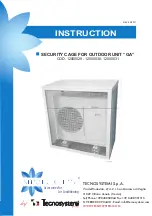
7 Installation
Installer reference guide
31
ERLQ004~008CA + 08S18CB
Daikin Altherma – Low temperature split
4P401676-1D – 2018.07
Charging additional refrigerant
Before charging additional refrigerant, make sure the outdoor unit's
external
refrigerant piping is checked (leak test, vacuum drying).
INFORMATION
Depending on the units and/or the installation conditions, it
might be necessary to connect electrical wiring before you
can charge refrigerant.
Typical workflow – Charging additional refrigerant typically consists
of the following stages:
1 Determining if and how much you have to charge additionally.
2 If necessary, charging additional refrigerant.
3 Filling in the fluorinated greenhouse gases label, and fixing it to
the inside of the outdoor unit.
Completely recharging refrigerant
Before completely recharging refrigerant, make sure the following is
done:
1 All refrigerant is recovered from the system.
2 The outdoor unit's
external
refrigerant piping is checked (leak
test, vacuum drying).
3 Vacuum drying on the outdoor unit's
internal
refrigerant piping is
performed.
NOTICE
Before completely recharging, perform vacuum drying on
the outdoor unit's
internal
refrigerant piping as well.
Typical workflow – Completely recharging refrigerant typically
consists of the following stages:
1 Determining how much refrigerant to charge.
2 Charging refrigerant.
3 Filling in the fluorinated greenhouse gases label, and fixing it to
the inside of the outdoor unit.
7.7.2
Precautions when charging refrigerant
INFORMATION
Also read the precautions and requirements in the
following chapters:
▪ General safety precautions
▪ Preparation
7.7.3
To determine the additional refrigerant
amount
If the total liquid
piping length is…
Then…
≤10 m
Do NOT add additional refrigerant.
>10 m
R=(total length (m) of liquid
piping–10 m)×0.020
R=Additional charge (kg) (rounded in units
of 0.1 kg)
INFORMATION
Piping length is the one-way length of liquid piping.
7.7.4
To determine the complete recharge
amount
INFORMATION
If a complete recharge is necessary, the total refrigerant
charge is: the factory refrigerant charge (see unit name
plate) + the determined additional amount.
7.7.5
To charge additional refrigerant
WARNING
▪ Only use R410A as refrigerant. Other substances may
cause explosions and accidents.
▪ R410A contains fluorinated greenhouse gases. Its
global warming potential (GWP) value is 2087.5. Do
NOT vent these gases into the atmosphere.
▪ When charging refrigerant, always use protective
gloves and safety glasses.
CAUTION
To avoid compressor breakdown, do NOT charge more
than the specified amount of refrigerant.
Prerequisite:
Before charging refrigerant, make sure the refrigerant
piping is connected and checked (leak test and vacuum drying).
1
Connect the refrigerant cylinder to the service port.
2
Charge the additional refrigerant amount.
3
Open the gas stop valve.
If pump down is needed in case of dismantling or relocating the
system, see
"13.2 To pump down" on page 72
for more details.
7.7.6
To fix the fluorinated greenhouse gases
label
1
Fill in the label as follows:
b
Contains fluorinated greenhouse gases
2
1
1
1
2
2
kg
tCO
2
eq
GWP × kg
1000
=
=
+
kg
=
kg
=
GWP: XXX
RXXX
a
f
c
d
e
a
If a multilingual fluorinated greenhouse gases label is
delivered with the unit (see accessories), peel off the
applicable language and stick it on top of
a
.
b
Factory refrigerant charge: see unit name plate
c
Additional refrigerant amount charged
d
Total refrigerant charge
e
Greenhouse gas emissions
of the total refrigerant charge
expressed as tonnes CO
2
equivalent
f
GWP = Global warming potential
NOTICE
In Europe, the
greenhouse gas emissions
of the total
refrigerant charge in the system (expressed as tonnes CO
2
equivalent) is used to determine the maintenance intervals.
Follow the applicable legislation.
Formula to calculate the greenhouse gas emissions:
GWP value of the refrigerant × Total refrigerant charge [in
kg] / 1000
2
Fix the label on the inside of the outdoor unit near the gas and
liquid stop valves.
















































